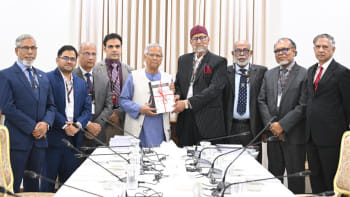The Bhawal story through women’s voices in Aruna Chakravarti’s ‘The Mendicant Prince’

Indian writer Aruna Chakravarti has carved a special place in Bangladesh through her notable historical fiction about Bengal of different eras. One of her most popular novels is about the women of Tagore's family, The Daughters of Jorasanko (HarperCollins India, 2016).
Now, in her recent and riveting historical fiction: The Mendicant Prince (Picador India, 2022) we encounter the qualities that are her forte: a detailed evocation of a period through the inner lives of women.
Amitav Ghosh describes the novel as a "retelling of the Bhawal Sanyasi case". I don't know about the Bangladeshi readers of today, but for those like myself who grew up in Dhaka in the '60's and 70's, the Bhawal legend is a familiar one. It happened in our backyard, and conjures for my generation personal associations: visits to the Bhawal palace in Joydebpur (now Ghazipur) in what was the green outskirts of Dhaka, and picnics in the surrounding Modhupur forests, later the Bhawal National Park.
So, even if we did not know many details about the Bhawal family, as we learn from Chakravarti's meticulously researched novel, we knew the story of the ailing Bhawal prince, Ramendranarayan Roy, the Mejo Kumar, who while taken to Darjeeling to recuperate, died and was cremated there, under mysterious circumstances, and who then returned years later as a wandering ascetic with partial amnesia! Recognised by his subjects and some family members, he became the focus of the famous court battle to reinstate him as the ruler, against the will of his wife, the Mejo Rani, who contested that claim insisting the man was an imposter. The case that started in 1930 in the District Court of Dhaka, ended 16 years later when a verdict from the Privy Council in London in 1946 declared the claimant to be the Raja of Bhawal.
So, how can a story that is already familiar to readers, become a compelling page turner? Under Aruna Chakravarti's pen, just such a transmutation takes place.
Part of the secret, perhaps, is in the narrative structure: a deft interweaving of chapters that are factual (exposition and backstory spliced with excerpts from actual official communications, legal notices, letters to newspapers, transcripts of court proceedings etc.); and chapters that are fictional (illustrative scenes recounted in first person, and in a variety of voices and personas: Hindu and Muslim tenants of the Bhawal estate; judges, lawyers, doctors and government officials, both native and British; and best of all, the ladies of the royal household).
So, the drama is cumulative, and here is an example of this regarding the Sannyasi's first appearance:
''My dear Lindsay, A very curious..thing…has created a..sensation throughout the Estate…About five months ago a fair complexioned mendicant came to Dacca…A week ago, the sadhu was ..brought to the house of Srj Jyotirmoyee Debi…Tenants..and the numerous people present began to utter 'Hullu-dhani'…convinced that he was…the 2nd kumar.." [Excerpts from a letter by Needham, Manager of the Bhawal estate, to Lindsay, Collector and District Magistrate of Dhaka]
"At last the Rajbari has woken to the fact that the Sannyasi is the mejo kumar. We, the subjects, had recognized him months ago….Yesterday….people started gathering outside the second Rajkumari's house… Suddenly a hush fell on the assembly….The Sannyasi was standing on the balcony …Suddenly a little old woman…cried in a ..quavering voice. 'What was your milk mother's name?...' 'Aloka'…The woman burst into…sobs. "You remember me!"..And now the people went delirious. 'Jai! Mejo Kumar er jai!' Women began ululating…" [Taufique Ali]
But, I feel, the immediacy of the narrative is even stronger in Chakravarti's deeply imagined female characters who bring interiority and unpredictability to what could have been a dry legalistic narrative of foregone conclusions. Instead the tale is animated by the voices of the three sisters and a sister-in-law of the protagonist prince; his mistress Elokeshi, his first wife, the multilayered Mejo Rani Bibhavati and his last wife Dhara.
They come alive as believable women, with their unspoken thoughts ("Suddenly I felt a presence in the room..he was my golden god…Follow your heart..This is a moment of destiny.." Jyotirmoyee Debi) or half-articulated fears, ("I got my first glimpse of the Rajbari, which was to be my home..the shadows of dusk were closing around us. A colossal structure loomed.." Bibhavati), even forbidden thoughts (" I put up with my husband's clumsy attempts to impregnate me…by shutting my eyes, and thinking about Jyoti babu." Anandakumari); and they in turn bring to life a by-gone world with the sensory details of their cloistered worlds ("The daily routine of being massaged, bathed and dressed by serving women…became more acceptable..I even got used to..the long ghumta..fixed to my khonpa with diamond clasps and pulled down whenever I left my rooms." Bibhavati).
Often, the women provide clarity if not explanation for unsubstantiated aspects of the story, like the rumour of an incestuous relationship between the Mejo Rani and her brother. Chakravarti touches on these with skill and sensitivity that we might arrive at our own conclusions, and through multiple voices, both female and male, gain fresh perspective on long ago lives.
We know how the story ends. And yet I could not put the book down till the last resonant page, where an inevitable end is made poignant yet jubilant. Such is the promise of Chakravarti's fictionalized version of our Bhawal story.
Aruna Chakravarti will be at the Dhaka Lit Fest in January to speak about her book, which is available now at Bookworm Bangladesh.
Neeman Sobhan is an Italy based Bangladeshi writer of short stories, presently working on her first novel. She has authored a collection of short stories, Piazza Bangladesh, poems Calligraphy of Wet Leaves, and an anthology of her columns for The Daily Star, Ruminations from Rome.

 For all latest news, follow The Daily Star's Google News channel.
For all latest news, follow The Daily Star's Google News channel. 








Comments